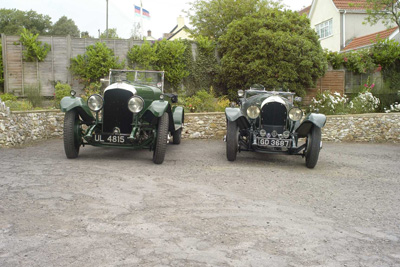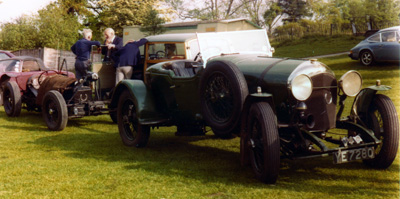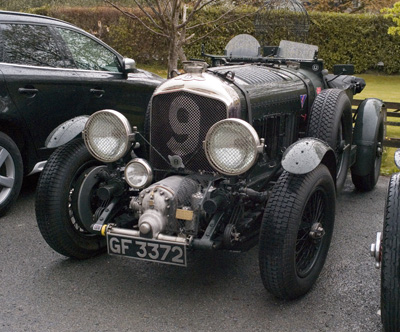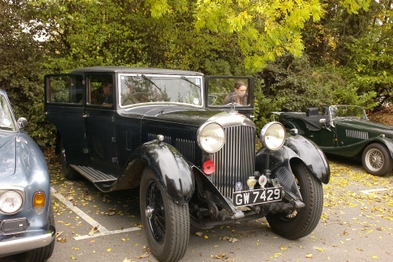
| Vintage | | | Derby | | | Post-war | | | Crewe monocoque | | | Crewe modern | | | Specials |
| Category | Period | Made by | Also known as | Types |
|---|---|---|---|---|
| Vintage Bentleys | 1919-1931 | W O Bentley | WO cars; Cricklewood Bentleys | 3, 4½, 6½, 8 and 4 litre |
| Derby Bentleys | 1931-1939 | Rolls Royce | Rolls Bentleys* (non-U) | 3½, 4¼ and Mk V |
| Post-war | 1946-1965 | Rolls Royce | Crewe cars (chassis-based) | Mk VI, R type, S types |
| Modern | 1965-1998 | Rolls Royce | Moderns; Crewe cars (monococque) | T types, Mulsanne, Turbo R, Continental R, Azure |
| Modern (post-1998) | 1998-date | Bentley Motors | Moderns; Crewe cars (VW era) | Arnage, Continental GT/GTC/Flying Spur, Brooklands, Azure, Mulsanne, New Flying Spur |
| Specials | 1922-date | Various | Various | Various |
* An infelicitous term, best not used in the company of Bentley afficionados
Not everyone would agree with my sub-division of the post-war cars; some might further sub-divide the period at 1971 to reflect the formation of Rolls Royce (1971) Ltd, when Rolls Royce Motors was separated from the aeroplane business. By 1998, Rolls Royce Motors was owned by Vickers, who sold it to BMW, but sold the Bentley name and the Crewe factory to Volkswagen; that is the basis for my sub-division.
This is not intended as an historical account, but a rough guide to identifying Bentley motor cars that you may see on the road or at "classic car" events. Errors and omissions are mine alone. For a detailed historical account, the Bentley Motors website breaks the history down decade by decade. Another interesting site is K J Rossfeldt's rrab.com, which claims to have photographs of every model of Rolls Royce and Bentley ever built. I make no such attempt, but concentrate instead on details by which Bentley models may be distinguished one from another.
There are five models, two with four-cylinder engines and three with six-cylinders, though the last of the six-cylinder engines (the 4 litre) was not a W O Bentley design. Bentley's engines were designed for power and reliability, with non-detachable cylinder heads and four valves per cylinder, operated by a single overhead camshaft.
Seen individually, the most obvious difference is that the radiator of the 4½ litre is both wider and taller, to dissipate the additional heat from the larger engine. The curvature at the top is also subtly different, as shown in the following photographs.
The extra height gives the 4½ litre cars a larger "presence" than a 3 litre.


Left: the Bentley 3 litre radiator is straight-bottomed, with starting handle below.
Right: the Bentley 4½ litre radiator extends down on either side of the starting handle guide, which sits in an inverted "U".
Unfortunately for the Bentley-spotter, this is only a guide, since a good many 3 litre cars have been fitted subsequently with 4½ litre engines, but seldom with 4½ litre radiators. Such cars are known as "3/4½"s. The majority of surviving 4-cylinder Bentleys have been considerably modified during the 80-years since the Cricklewood factory closed, so the only way to be sure of what you are looking at is to know the car's history or to see it with its bonnet open on the exhaust side. The exhaust manifolds are different: the 3 litre's is attached by four bolts to its downpipe, whilst the 4½'s has eight.






Except for the 4 litre, the six-cylinder Vintage Bentleys can be distinguished by the presence of a dynamo casing (quite different from the supercharger of a "Blower") at the base of the radiator. (Confusingly, some very early cars had dynamos driven from the rear of the engine, though whether any of these survive unmodified I do not know.)





These two photographs of another Standard 6½ clearly show the inlet attangements and tapered radiator shell. Note also that the inlet is on the left side of the engine and, ergo, the exhaust must be on the right. The 6½ is the only Bentley engine with this conformation, so a right-hand exhaust is another clue to its identity compared with the 8 litre. The reason for this seems to be that there was difficulty in finding room for the throttle linkage on the same side as the steering column; the difficulty was evidently overcome when the 8 litre was designed.

The 8 litre is distinguished by a vaned radiator shell. This one has a paint-finished dynamo casing and wheel discs. The radiator vanes were thermostatically-controlled to aid fast warming of the engine from cold and to maintain a constant temperature thereafter.

The absence of a dynamo beneath the radiator distinguishes this from an 8 litre Bentley. The wheel nuts (spinners) clearly identify this as a Cricklewood car. Derby-built cars were quite different.
March 2014, updated July 2015